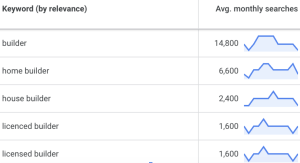This article outlines some of the challenges and strategies we overcame to rank a client website for “custom home builder Central Coast”.
Phase 1: Local SEO audit and goals
Our research showed that “builder” is the most common phrase. However this would include a range of irrelevant phrases like “bob the builder”. Next is “home builder” which curiously is triple what “house builder” receives in a month. Adding the qualifier “custom home builder” was still half as much as “home builder” and probably our pick in terms of phrases to target. “Licensed builder” and “licenced builder” were both equal. (This is consistent with Google’s ability to understand synonyms.) Then there was the usual concoction of various location phrases like “local builder”, “builder near me” and “builder in my area”.

Starting point: Local SEO visibility check
Luke’s website had been built by Yellow Pages many years earlier. And he admitted it used to rank well and bring in leads. However, the rankings fell away over the years. When we looked at it, the content was all very generic and not representative of Luke’s points of difference. So we replaced it with a website with more accurate content, a good page structure, and a clear indication of being a local licensed custom builder on the Central Coast.
Competitor insights: Who’s ranking for “Custom Home Builder Central Coast”?
There is strong competition for the phrase “custom home builder Central Coast” with the search results dominated by ads, local search ads, and some prominent Central Coast builders.
Keyword targeting: Pinpointing high-value local and custom home builder keywords
The chances to win are by adding “custom” throughout the website, and publishing specific suburb names like Wamberal, Terrigal, Foresters Beach and Tumbi Umbi.
Measuring local success: Enquiries and conversions
The only important outcome in this campaign is enquiries. So we got to work publishing content not just for ranking but for helping someone choose Luke as their builder. And we leaned in to his difference, regarding experience, attention to detail, and focusing on one project at a time. He is not looking to go up against a project home company. So his ideal client will want the personal service and focus that a custom home builder like Luke Wall Constructions can deliver.
Phase 2: Google Business Profile (GBP) optimisation for local SEO
The GBP is essential for local search ranking; these highlight its importance:
Creating and optimising the Google Business Profile
At first there was no listing for Luke Wall Constructions. This is unusual these days, for a builder that has been trading for this long. But it does still happen.
Choosing the right primary business category
There was a choice between a “construction company” and a “home builder” as categories. We chose “home builder” as the primary. Unfortunately we cannot get “custom” into the primary category.
Getting the first client reviews
For a builder of custom homes there are far fewer clients per year than a business like a cafe or a salon. So reviews are a challenge, even though all of Luke’s clients have been very happy with his work over the years. However, he reached out to previous contacts and was able to secure 5 glowing reviews almost immediately after the Google Business Profile went live. This has helped his profile visibility and also its trust signals.
Phase 3: On-site SEO and content strategy
This section covers website changes necessary to support the GBP and organic ranking.
Optimising on-site local SEO signals
(Focus: NAP consistency, schema markup, and general on-page SEO.)
Projects portfolio: Adding local projects to improve suburb rankings
A key tactic we used here was to publish a portfolio page for previous projects Luke has built. This always includes the type of build and the name of the suburb. It has already resulted in significant ranking improvements for those specific suburbs.
Phase 4: Building authority and trust
Reviews and links are the fuel for strong local SEO performance.
Earning trust online with high-quality Google reviews
(Focus: How the client encourages, manages, and responds to reviews – the volume and quality factor.)
Directory listings and citations
We ensure the listings in the key directories are correct if they already exist, or are added if they are not yet listed on those directories. We also list the project on some lesser known but hyper-local directories to gain a different spread of directories to other competitor websites.
Transparent content: Why this blog supports our local SEO strategy
We also publish some helpful content articles on other websites with links pointing to the website. This helps the GBP and the website to be more visible in search engines. This article is actually part of the strategy, outlining the challenge and strategies of local SEO, while linking to his website from a prominent Central Coast website. It all contributes to the reputation and results of a client website.